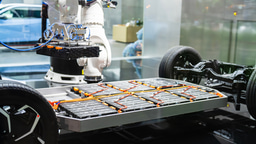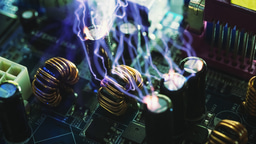Interpretable Machine Learning-Guided Plasma Catalysis for Hydrogen Production
Published in Sustainability and Mathematical & Computational Engineering Applications

The Motivation
The maritime shipping, the backbone of global trade, burns massive amounts of fossil fuels, pumping nearly 8 billion metric tons of CO2 annually. Decarbonizing these giant vessels is one of the great challenges of the energy transition. Hydrogen (H2) is a clean alternative, but storing and transporting it, on a massive container ship, is difficult. This is where ammonia (NH3) comes in. It’s a H2-rich molecule that is much easier to liquefy and ship. It is ideal to have ships carry NH3 and then efficiently “crack” it on-demand into pure H2, combined with H2 fuel cell, to power the engines.
Turning that vision into reality is far from simple. Cracking NH3 is inherently challenging: the most effective catalyst, ruthenium (Ru), is both expensive and scarce, while more affordable metals like Ni, Co, or Fe require much higher temperatures. These conditions waste energy, increase costs, and make the process less sustainable. For decades, this trade-off has persisted, either rely on rare metals or sacrifice efficiency with energy-intensive alternatives.
Our team set out to overcome this barrier by asking a simple question: Can NH3 decomposition be made cheaper, cleaner, and more efficient using earth-abundant materials? To answer it, we turned to two powerful tools: non-thermal plasma (NTP) and machine learning (ML) screening. Plasma, a reactive state of matter, generates energetic electrons, radicals, and vibrationally excited molecules that enable reactions at lower temperatures, reducing energy demands. Meanwhile, ML screening rapidly narrows down promising catalyst candidates from a vast design space. Guided by multi-scale simulations, our interpretable ML models not only identify effective catalysts but also reveal the underlying physics driving performance.
This pursuit of a sustainable H2 economy drove our recent work, published in Nature Chemical Engineering. We weren’t just looking for a catalyst; we were seeking an AI-guided catalyst design platform.
The Approach
NTP breaks the limitations of conventional catalysis. Instead of relying on high temperatures to overcome kinetic barriers, plasma generates a series of excited species, radicals, and vibrationally excited NH3 molecules, that can bypass the toughest reaction steps. In theory, this could lower operating temperatures and open-up new catalytic pathways.
But plasma catalysis is complex. Which catalysts work best under plasma conditions? How to avoid costly trial-and-error testing across thousands of candidates? Here is where interpretable ML entered our workflow. Using insights from multi-scale simulation from atomic-to-reactor scales, we identified nitrogen adsorption energy (EN) as a key descriptor of catalytic activity under both thermal and plasma conditions. Under thermal conditions, the “sweet spot” was around -0.9 eV, favoring Ru. But under plasma, our models showed the optimum shift to -0.5 eV, placing inexpensive Co at the top of the volcano plot.
Armed with this descriptor, we developed interpretable ML models to screen over 3,300 alloy compositions and quickly identified four optimal catalysts made from earth-abundant materials. Importantly, SHAP (Shapley Additive Explanations) analysis revealed that d-band filling is the key factor governing catalytic performance.
Challenges and Surprises
Scientific progress rarely follows a straight path, and this project was no exception. In the early stages, we encountered two major hurdles. On the computational side, the challenge was how to accurately capture plasma-specific effects on heterogeneous catalysis through multi-scale simulations. Our initial attempts, which considered only vibrational excitation, produced qualitative agreement with experiments but significantly underestimated catalytic activity. The turning point came during a collaborative discussion between theory and experiment, when Professor Fanglin Che raised a pivotal question: “What if we account for radical adsorption and radical-surface interactions through Eley-Rideal (E-R) pathways?” This idea expanded the model to include radical-surface interactions. The result was a framework that successfully bridged the quantitative gap between theory and experiment on the plasma catalytic activity.
One challenge of applying interpretable ML to bimetallic catalysts for NH3 decomposition is the sheer complexity of catalyst design space, with vast alloy combinations and surface configurations, extracting meaningful trends is nontrivial. Even when models achieve high accuracy, ensuring that predictions are physically interpretable and chemically consistent remains a challenge. A key surprise came when SHAP analysis consistently highlighted d-band filling as the dominant descriptor of catalytic activity, aligning with fundamental catalysis theory. This provided our confidence that interpretable ML can both accelerate discovery and uncover underlying physics.
Together with ML, techno-economic analysis (TEA) and life cycle assessment (LCA), we showed that plasma reshapes the catalyst landscape, identifying earth-abundant alloys such as Ni3Mo, Fe3Cu, Ni7Cu, and Fe15Ni as cost-effective, low-carbon alternatives for H2 production. TEA further highlighted that Ni3Mo, for example, could deliver H2 at costs below $1 per kilogram with a carbon footprint of ~0.91 kg CO2 per kilogram H2, aligning with DOE’s future targets.
Outlook
The ML-guided simulation framework developed in this project has applications far beyond H2 production from NH3. By integrating ab-initio simulations, microkinetic modeling, and interpretable ML, it paves the way for a new paradigm in catalyst design, one grounded in fundamental understanding rather than trial-and-error experimentation.
From this study, we have shown that NH3 cracking can generate H2 under plasma conditions with high energy efficiency and low cost, making it viable both for purpose-built ships and for integration into retrofitted systems. More broadly, plasma catalysis offers exciting potential for activating other stable molecules such as CO2, N2, and CH4 under mild conditions, expanding its relevance to multiple decarbonization pathways.
Equally important is the collaborative spirit that enabled this progress. By bringing together expertise in plasma physics, catalysis, AI, and economics, this work demonstrates how true innovation often arises at the intersection of disciplines.
Follow the Topic
-
Nature Chemical Engineering

This is a new monthly online journal dedicated to publishing the most significant original research, commentary and analysis of direct relevance to the diverse community of chemical engineers.
What are SDG Topics?
An introduction to Sustainable Development Goals (SDGs) Topics and their role in highlighting sustainable development research.
Continue reading announcement




Please sign in or register for FREE
If you are a registered user on Research Communities by Springer Nature, please sign in